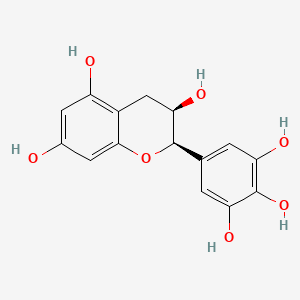| MeSH term | MeSH ID | Detail |
|---|---|---|
| Body Weight | D001835 | 333 associated lipids |
| Lung Neoplasms | D008175 | 171 associated lipids |
| Adenocarcinoma | D000230 | 166 associated lipids |
| Hemolysis | D006461 | 131 associated lipids |
| Pancreatic Neoplasms | D010190 | 77 associated lipids |
| Mammary Neoplasms, Experimental | D008325 | 67 associated lipids |
| Liver Diseases | D008107 | 31 associated lipids |
| Glioblastoma | D005909 | 27 associated lipids |
(-)-Epigallocatechin
(-)-Epigallocatechin is a lipid of Polyketides (PK) class. The involved functions are known as Protective Agents, inhibitors, Process, Drug Kinetics and Fermentation. (-)-epigallocatechin often locates in Hepatic, Blood, Membrane, Back and apical membrane. The associated genes with (-)-Epigallocatechin are ADRBK1 gene and FASTK Gene. The related lipids are 1,2-dilinolenoyl-3-(4-aminobutyryl)propane-1,2,3-triol. The related experimental models are Rodent Model and Transgenic Model.
Cross Reference
Introduction
To understand associated biological information of (-)-Epigallocatechin, we collected biological information of abnormalities, associated pathways, cellular/molecular locations, biological functions, related genes/proteins, lipids and common seen animal/experimental models with organized paragraphs from literatures.
What diseases are associated with (-)-Epigallocatechin?
There are no associated biomedical information in the current reference collection.
Possible diseases from mapped MeSH terms on references
We collected disease MeSH terms mapped to the references associated with (-)-Epigallocatechin
PubChem Associated disorders and diseases
What pathways are associated with (-)-Epigallocatechin
There are no associated biomedical information in the current reference collection.
PubChem Biomolecular Interactions and Pathways
Link to PubChem Biomolecular Interactions and PathwaysWhat cellular locations are associated with (-)-Epigallocatechin?
Visualization in cellular structure
Associated locations are in red color. Not associated locations are in black.
Related references are published most in these journals:
| Location | Cross reference | Weighted score | Related literatures |
|---|
What functions are associated with (-)-Epigallocatechin?
Related references are published most in these journals:
| Function | Cross reference | Weighted score | Related literatures |
|---|
What lipids are associated with (-)-Epigallocatechin?
Related references are published most in these journals:
| Lipid concept | Cross reference | Weighted score | Related literatures |
|---|
What genes are associated with (-)-Epigallocatechin?
Related references are published most in these journals:
| Gene | Cross reference | Weighted score | Related literatures |
|---|
What common seen animal models are associated with (-)-Epigallocatechin?
Rodent Model
Rodent Model are used in the study 'Dietary (-)-epicatechin as a potent inhibitor of βγ-secretase amyloid precursor protein processing.' (Cox CJ et al., 2015) and Rodent Model are used in the study 'Effects of dosing condition on the oral bioavailability of green tea catechins after single-dose administration of Polyphenon E in healthy individuals.' (Chow HH et al., 2005).
Transgenic Model
Transgenic Model are used in the study 'Dietary (-)-epicatechin as a potent inhibitor of βγ-secretase amyloid precursor protein processing.' (Cox CJ et al., 2015).
Related references are published most in these journals:
| Model | Cross reference | Weighted score | Related literatures |
|---|
NCBI Entrez Crosslinks
All references with (-)-Epigallocatechin
Download all related citations| Authors | Title | Published | Journal | PubMed Link |
|---|---|---|---|---|
| Ito H et al. | Antitumor activity of compounds isolated from leaves of Eriobotrya japonica. | 2002 | J. Agric. Food Chem. | pmid:11929303 |
| Sartippour MR et al. | Green tea and its catechins inhibit breast cancer xenografts. | 2001 | Nutr Cancer | pmid:11962250 |
| Plumb GW et al. | Antioxidant properties of gallocatechin and prodelphinidins from pomegranate peel. | 2002 | Redox Rep. | pmid:11981454 |
| Kida K et al. | Deodorizing effects of tea catechins on amines and ammonia. | 2002 | Biosci. Biotechnol. Biochem. | pmid:11999411 |
| Hynes MJ and Coinceanainn MO | Investigation of the release of iron from ferritin by naturally occurring antioxidants. | 2002 | J. Inorg. Biochem. | pmid:12009251 |
| Sachinidis A et al. | Inhibition of the PDGF beta-receptor tyrosine phosphorylation and its downstream intracellular signal transduction pathway in rat and human vascular smooth muscle cells by different catechins. | 2002 | FASEB J. | pmid:12039871 |
| Levites Y et al. | Involvement of protein kinase C activation and cell survival/ cell cycle genes in green tea polyphenol (-)-epigallocatechin 3-gallate neuroprotective action. | 2002 | J. Biol. Chem. | pmid:12058035 |
| Young JF et al. | Green tea extract only affects markers of oxidative status postprandially: lasting antioxidant effect of flavonoid-free diet. | 2002 | Br. J. Nutr. | pmid:12064344 |
| Satoh K et al. | Inhibition of aromatase activity by green tea extract catechins and their endocrinological effects of oral administration in rats. | 2002 | Food Chem. Toxicol. | pmid:12065214 |
| Morris K | Tea chemicals confirmed as cancer-busting compounds. | 2002 | Lancet Oncol. | pmid:12067792 |
